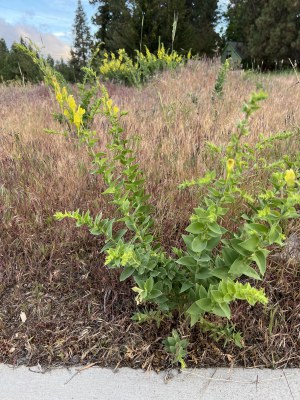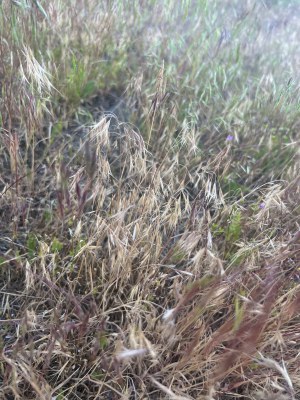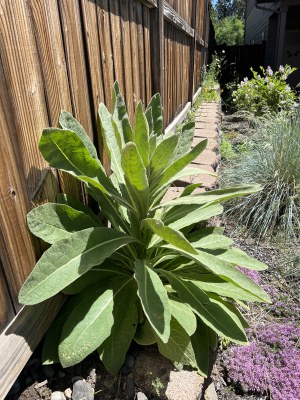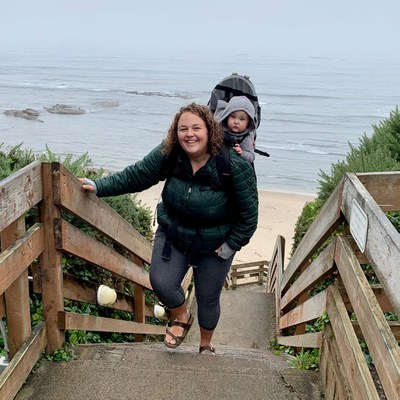This is part of a series on nature identification for kids. Read the first blog post of the series, Nature Identification with Kids.
Teaching kids about invasive species is a fun type of plant ID for two reasons. One is that, as they say, many hands make light work. The more people around our community who can recognize and combat invasive species on their morning walks and trips to the park, the more we can preserve biodiversity and native habitats in our region. The second is that kids love a good superhero narrative! Invasive species are the archetypal bad guy in this story, trying to take over, and our kids (and us!) are the heroes, trying to protect the native species and their habitat.

These flowering plants are often easy to spot—they are tall and have pretty yellow flowers. In fact, they were planted here because people find them so lovely to look at! But then, they escaped and have been spreading like wild.
Super hero mission: As a super hero fighting invasive species, you have a few jobs to help stop yellow toad flax in Central Oregon. The first is easy: it might be pretty, but please don’t plant it at your house! The next is to watch out for areas where it might be invading and try to stop it! You can pull it out, and the more of the root you get, the better. A note—it has been known to cause skin irritation for some people, so consider wearing gloves and long sleeves when pulling or touching these guys.

Cheatgrass is one nasty fellow. It is hard to get rid of, it grows everywhere like it owns the place, when it is dry it fuels fires, and (maybe worst of all) its seeds are like little splinters that can poke animals, including our pets, in their paws and ears. To be a super hero, if you find a patch of cheatgrass you want to tackle, you can hand pull them and put them into trash bags while the seeds are still attached to the plant. Bagging them up is an important step, because the seed heads can germinate after you’ve yanked them.

You might know mullein by one of its funny nicknames, like cowboy toilet paper or donkey ear. If it wasn’t as prolific and invasive as it is, it would just be super fun and interesting to learn about! It has some medicinal properties, and people have long used it for things like making tea that helps with respiratory congestion. Mullein has soft, fuzzy leaves that are fun to play with, and lead to other creative uses (see the nickname cowboy toilet paper…), and it has tall, pretty yellow flowering stalks. It is also so prolific that it takes over areas of disturbed soil and crowds out native species, which is why it is considered invasive. If you want to battle mullein in your neighborhood, the best way to get ride of it is by pulling it and getting the tap root out. If the plant you are getting out has flowered, bag it up so that the seeds cannot spread. Mullein loves disturbed soil, so, as always, protect thriving healthy native plants and ecosystems, and try to avoid disturbing soil when you can.
These are only a few of the invasive species in our area. Some others that you and your little super heroes can look for are: orange hawkweed, tumble mustard, Russian thistle, spotted knapweed, and puncture vine.
Join us for future identification with kids blog posts!
This blog post was written by Land Trust volunteer Nicole Gricius! Thanks Nicole!
Learn more:
- Central Oregon Invasive Weed Guide
- Nature Identification with Kids
- Making the Summer Solstice Fun with Your Kids
 Nicole Gricius is a native Oregonian, and she returned to Central Oregon with her partner to raise their three children and share her love of the outdoors with them. She has a PhD in Clinical Sexology and a Masters of Science in Counseling Psychology from Alaska Pacific University. She enjoys working as a psychotherapist in private practice, and plays as much as possible, including hiking, camping, skiing, kayaking, snowshoeing, and more.
Nicole Gricius is a native Oregonian, and she returned to Central Oregon with her partner to raise their three children and share her love of the outdoors with them. She has a PhD in Clinical Sexology and a Masters of Science in Counseling Psychology from Alaska Pacific University. She enjoys working as a psychotherapist in private practice, and plays as much as possible, including hiking, camping, skiing, kayaking, snowshoeing, and more.


